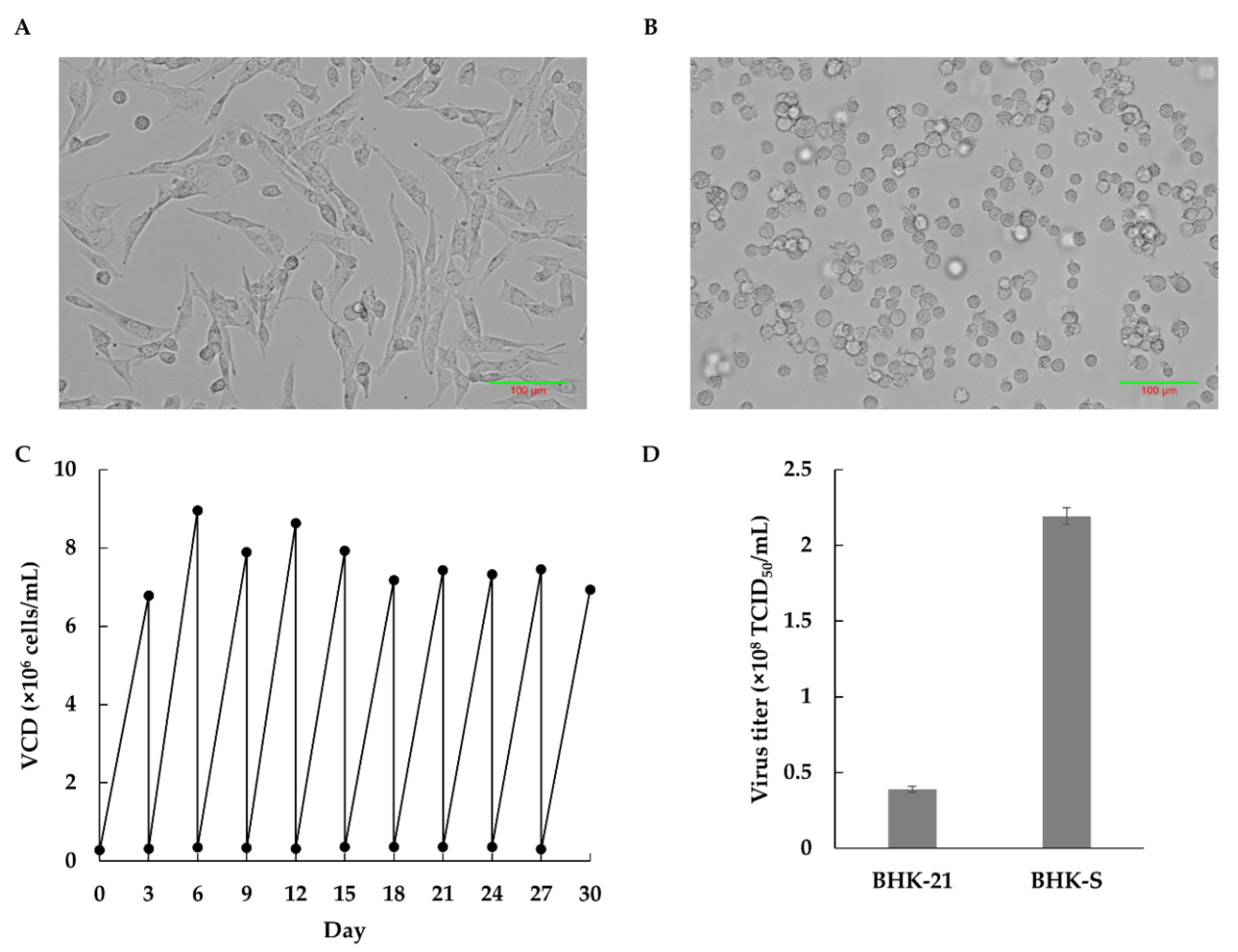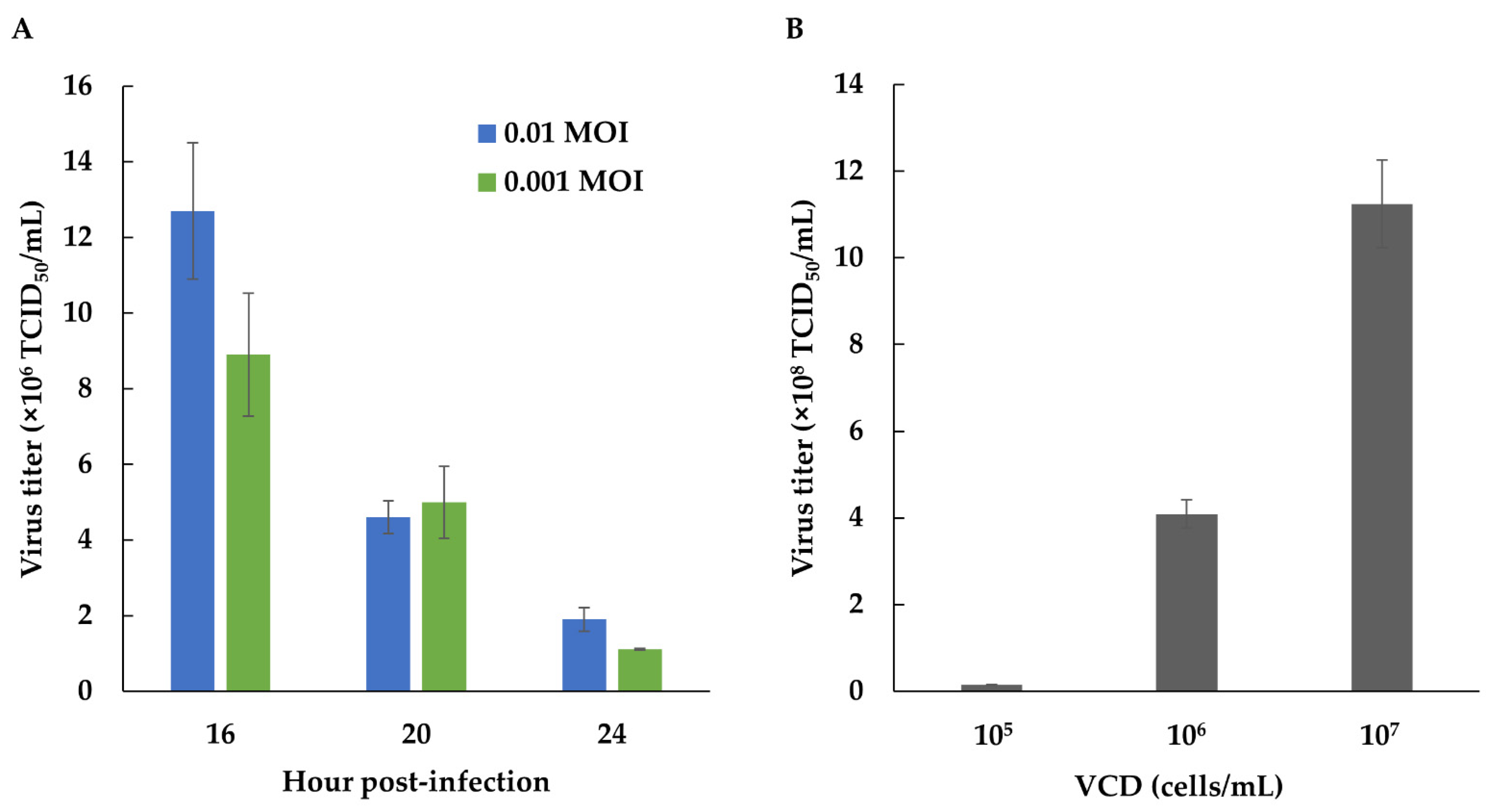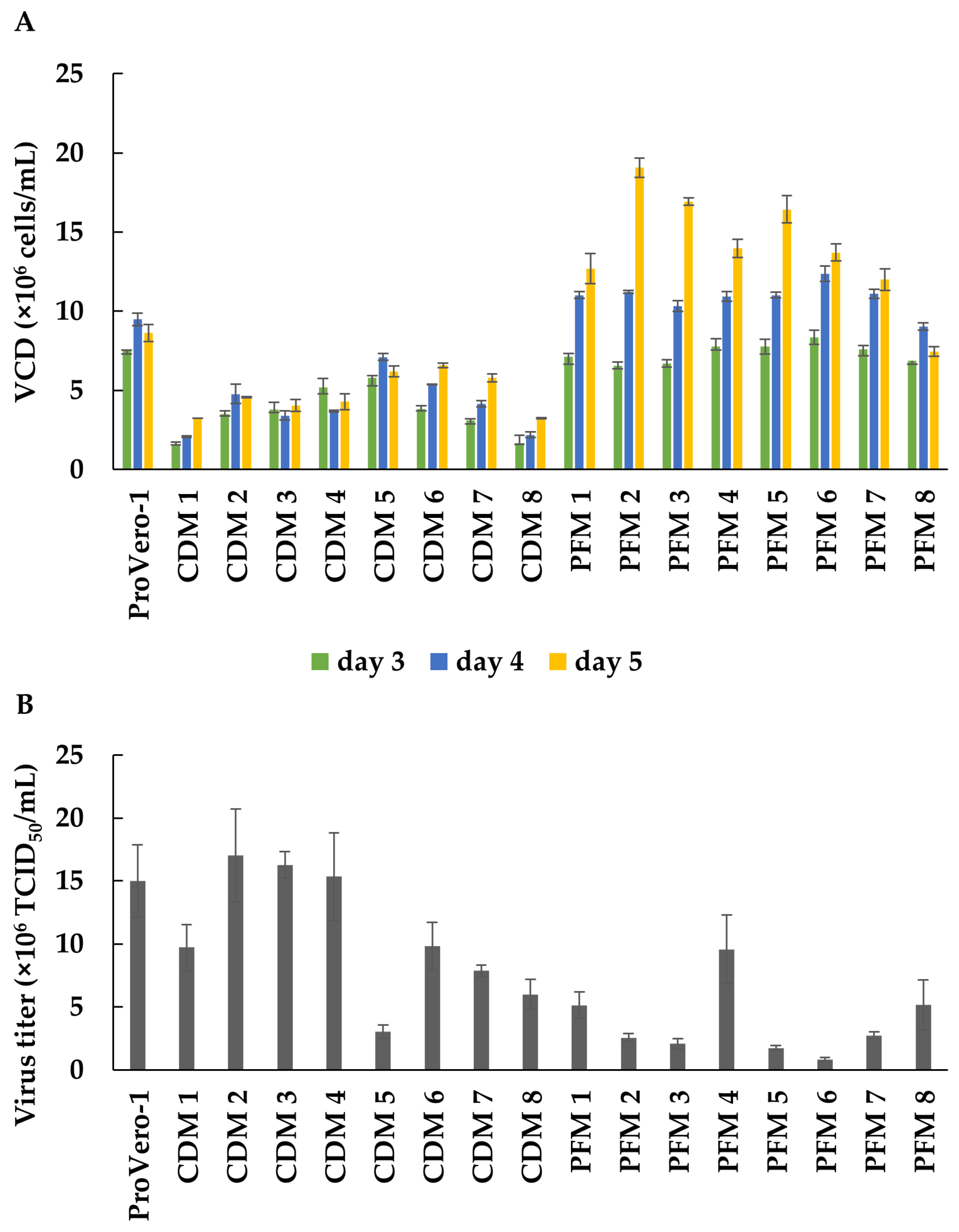Production of a Foot-and-Mouth Disease Vaccine Antigen Using Suspension-Adapted BHK-21 Cells in a Bioreactor
Abstract
:1. Introduction
2. Materials and Methods
2.1. Cell Lines, Cell Culture Media, and FMDV
2.2. Suspension Adaptation of Adherent BHK-21 Cells and Maintenance of a BHK-21 Suspension (BHK-S) Culture
2.3. Cell-Adhesion Assay
2.4. Development of Serum-Free Medium for BHK-S Cells
2.5. Propagation and Titration of FMDV
2.6. 146S Antigen Quantification
2.7. Optimizing BHK-S Batch Culture
2.8. Scaled Up FMDV Production in 50 L and 200 L Bioreactors
3. Results
3.1. Suspension Adaptation and BHK-S Cell Growth
3.2. ECM Properties of BHK-S Cells
3.3. FMDV Susceptibility and Productivity of BHK-S Cells
3.4. Developing Serum-Free Medium for BHK-S Cells
3.5. Optimizing BHK-S Batch Culture and Scaled-Up FMDV Production in a Bioreactor
4. Discussion
5. Conclusions
Author Contributions
Funding
Institutional Review Board Statement
Informed Consent Statement
Data Availability Statement
Acknowledgments
Conflicts of Interest
References
- Grubman, M.J.; Baxt, B. Foot-and-Mouth Disease. Clin. Microbiol. Rev. 2004, 17, 465–493. [Google Scholar] [CrossRef] [Green Version]
- Waldmann, O.; Zimmermann, T. Preparation of foot and mouth disease vaccine according to Waldmann and Köbe using calves as the antigen source. Zentralbl. Bakteriol. 1955, 163, 239. [Google Scholar]
- Frenkel, H.S. Research on foot-and-mouth disease. II. The cultivation of the virus in explanations of tongue epithelium of bovine animals. Am. J. Veter. Res. 1950, 11, 371–373. [Google Scholar]
- Macpherson, I.; Stoker, M. Polyoma transformation of hamster cell clones—An investigation of genetic factors affecting cell competence. Virology 1962, 16, 147–151. [Google Scholar] [CrossRef]
- Mowat, G.N.; Brooksby, J.B.; Pay, T.W.F. Use of BHK 21 Cells in the Preparation of Mouse Attenuated Live Foot-and-Mouth Disease Vaccines for the Immunization of Cattle. Nat. Cell Biol. 1962, 196, 655–656. [Google Scholar] [CrossRef] [PubMed]
- Mowat, G.N.; Chapman, W.G. Growth of Foot-and-Mouth Disease Virus in a Fibroblastic Cell Line Derived from Hamster Kidneys. Nat. Cell Biol. 1962, 194, 253–255. [Google Scholar] [CrossRef] [PubMed]
- Capstick, P.B.; Telling, R.C.; Chapman, W.G.; Stewart, D.L. Growth of a Cloned Strain of Hamster Kidney Cells in Suspended Cultures and their Susceptibility to the Virus of Foot-and-Mouth Disease. Nat. Cell Biol. 1962, 195, 1163–1164. [Google Scholar] [CrossRef]
- Telling, R.C.; Elsworth, R. Submerged culture of hamster kidney cells in a stainless steel vessel. Biotechnol. Bioeng. 1965, 7, 417–434. [Google Scholar] [CrossRef]
- Gstraunthaler, G.; Lindl, T.; Van Der Valk, J. A plea to reduce or replace fetal bovine serum in cell culture media. Cytotechnology 2013, 65, 791–793. [Google Scholar] [CrossRef] [Green Version]
- Even, M.S.; Sandusky, C.B.; Barnard, N.D. Serum-free hybridoma culture: Ethical, scientific and safety considerations. Trends Biotechnol. 2006, 24, 105–108. [Google Scholar] [CrossRef] [PubMed]
- Bellani, C.F.; Ajeian, J.; Duffy, L.; Miotto, M.; Groenewegen, L.; Connon, C.J. Scale-Up Technologies for the Manufacture of Adherent Cells. Front. Nutr. 2020, 7. [Google Scholar] [CrossRef]
- Al-Rubeai, M.; Warnock, J.N. Bioreactor systems for the production of biopharmaceuticals from animal cells. Biotechnol. Appl. Biochem. 2006, 45, 1–12. [Google Scholar] [CrossRef] [PubMed]
- Chiarugi, P.; Giannoni, E. Anoikis: A necessary death program for anchorage-dependent cells. Biochem. Pharmacol. 2008, 76, 1352–1364. [Google Scholar] [CrossRef] [PubMed]
- Yao, T.; Asayama, Y. Animal-cell culture media: History, characteristics, and current issues. Reprod. Med. Biol. 2017, 16, 99–117. [Google Scholar] [CrossRef]
- Jayme, D.W. Nutrient optimization for high density biological production applications. Cytotechnology 1991, 5, 15–30. [Google Scholar] [CrossRef]
- Zanghi, J.A.; Fussenegger, M.; Bailey, J.E. Serum protects protein-free competent Chinese hamster ovary cells against apoptosis induced by nutrient deprivation in batch culture. Biotechnol. Bioeng. 1999, 64, 108–119. [Google Scholar] [CrossRef]
- Doel, T.R.; Chong, W.K.T. Comparative immunogenicity of 146S, 75S and 12S particles of foot-and-mouth disease virus. Arch. Virol. 1982, 73, 185–191. [Google Scholar] [CrossRef]
- Cartwright, B.; Chapman, W.G.; Brown, F. Serological and Immunological Relationships between the 146S and 12S Particles of Foot-and-Mouth Disease Virus. J. Gen. Virol. 1980, 50, 369–375. [Google Scholar] [CrossRef] [PubMed]
- Park, J.-H.; Tark, D.; Lee, K.-N.; Chun, J.-E.; Lee, H.-S.; Ko, Y.-J.; Kye, S.-J.; Kim, Y.-J.; Oem, J.-K.; Ryoo, S.; et al. Control of type O foot-and-mouth disease by vaccination in Korea, 2014–2015. J. Veter. Sci. 2018, 19, 271–279. [Google Scholar] [CrossRef] [PubMed]
- Spearman, C. The method of ‘right and wrong cases’ (‘constant stimuli’) without gauss’s formulae. Br. J. Psychol. 1904–1920 1908, 2, 227–242. [Google Scholar] [CrossRef]
- Kärber, G. Beitrag zur kollektiven Behandlung pharmakologischer Reihenversuche. Naunyn-Schmiedeberg’s Arch. Pharmacol. 1931, 162, 480–483. [Google Scholar] [CrossRef]
- Doel, T.R.; Fletton, B.W.; Staple, R.F. Further developments in the quantification of small RNA viruses by U.V. photometry of sucrose density gradients. Dev. Biol. Stand. 1981, 50, 209–219. [Google Scholar]
- D’Anna, J.A.; Crissman, H.A.; Valdez, J.G.; Gurley, L.R.; Tobey, R.A. Synchronization of mammalian cells in S phase by sequential use of isoleucine-deprivation G1- or serum-withdrawal G0-arrest and aphidicolin block. J. Tissue Cult. Methods 1996, 18, 115–125. [Google Scholar] [CrossRef]
- Dimitrijevic-Bussod, M.; Balzaretti-Maggi, V.S.; Gadbois, D.M. Extracellular matrix and radiation G1 cell cycle arrest in human fibroblasts. Cancer Res. 1999, 59, 4843–4847. [Google Scholar]
- Van der Valk, J.; Brunner, D.; De Smet, K.; Svenningsen, Å.F.; Honegger, P.; Knudsen, L.; Lindl, T.; Noraberg, J.; Price, A.; Scarino, M.; et al. Optimization of chemically defined cell culture media—Replacing fetal bovine serum in mammalian in vitro methods. Toxicol. Vitr. 2010, 24, 1053–1063. [Google Scholar] [CrossRef] [Green Version]
- Moreira, J.; Alves, P.; Feliciano, A.; Aunins, J.; Carrondo, M. Serum-free and serum-containing media for growth of suspended BHK aggregates in stirred vessels. Enzym. Microb. Technol. 1995, 17, 437–444. [Google Scholar] [CrossRef]
- Renner, W.A.; Jordan, M.; Eppenberger, H.M.; Leist, C. Cell-cell adhesion and aggregation: Influence on the growth behavior of CHO cells. Biotechnol. Bioeng. 1993, 41, 188–193. [Google Scholar] [CrossRef]
- Gigout, A.; Buschmann, M.D.; Jolicoeur, M. The fate of Pluronic F-68 in chondrocytes and CHO cells. Biotechnol. Bioeng. 2008, 100, 975–987. [Google Scholar] [CrossRef]
- Jing, Y.; Egan, S.E.; Qian, Y.; Borys, M.C.; Abu-Absi, N.R.; Li, Z.J. Dextran sulfate inhibits staurosporine-induced apoptosis in Chinese hamster ovary (CHO) cells: Involvement of the mitochondrial pathway. Process. Biochem. 2011, 46, 427–432. [Google Scholar] [CrossRef]
- Shridhar, S.; Klanert, G.; Auer, N.; Hernandez-Lopez, I.; Kańduła, M.M.; Hackl, M.; Grillari, J.; Stralis-Pavese, N.; Kreil, D.P.; Borth, N. Transcriptomic changes in CHO cells after adaptation to suspension growth in protein-free medium analysed by a species-specific microarray. J. Biotechnol. 2017, 257, 13–21. [Google Scholar] [CrossRef] [PubMed]
- Liu, M.; Goudar, C.T. Gene expression profiling for mechanistic understanding of cellular aggregation in mammalian cell perfusion cultures. Biotechnol. Bioeng. 2012, 110, 483–490. [Google Scholar] [CrossRef] [PubMed]
- Kim, M.-S.; Myung-Sun, K.; Lee, M.-Y.; Kim, A.L.; Jo, M.H.; Kim, M.; Cho, S.-R.; Kim, Y.-H. Differential Expression of Extracellular Matrix and Adhesion Molecules in Fetal-Origin Amniotic Epithelial Cells of Preeclamptic Pregnancy. PLoS ONE 2016, 11, e0156038. [Google Scholar] [CrossRef] [Green Version]
- Kuschel, C.; Steuer, H.; Maurer, A.N.; Kanzok, B.; Stoop, R.; Angres, B. Cell adhesion profiling using extracellular matrix protein microarrays. Biotechniques 2006, 40, 523–531. [Google Scholar] [CrossRef]
- Walther, C.G.; Whitfield, R.; James, D.C. Importance of Interaction between Integrin and Actin Cytoskeleton in Suspension Adaptation of CHO cells. Appl. Biochem. Biotechnol. 2015, 178, 1286–1302. [Google Scholar] [CrossRef] [PubMed] [Green Version]
- Bachir, A.I.; Horwitz, A.R.; Nelson, W.J.; Bianchini, J.M. Actin-Based Adhesion Modules Mediate Cell Interactions with the Extracellular Matrix and Neighboring Cells. Cold Spring Harb. Perspect. Biol. 2017, 9, a023234. [Google Scholar] [CrossRef] [PubMed] [Green Version]
- Frantz, C.; Stewart, K.M.; Weaver, V.M. The extracellular matrix at a glance. J. Cell Sci. 2010, 123, 4195–4200. [Google Scholar] [CrossRef] [Green Version]
- Jean, C.; Gravelle, P.; Fournie, J.-J.; Laurent, G. Influence of stress on extracellular matrix and integrin biology. Oncogene 2011, 30, 2697–2706. [Google Scholar] [CrossRef] [PubMed] [Green Version]
- Streuli, C.H. Integrins and cell-fate determination. J. Cell Sci. 2009, 122, 171–177. [Google Scholar] [CrossRef] [PubMed] [Green Version]
- Kim, S.-H.; Turnbull, J.; Guimond, S. Extracellular matrix and cell signalling: The dynamic cooperation of integrin, proteoglycan and growth factor receptor. J. Endocrinol. 2011, 209, 139–151. [Google Scholar] [CrossRef] [PubMed] [Green Version]
- Frisch, S.M.; Francis, H. Disruption of epithelial cell-matrix interactions induces apoptosis. J. Cell Biol. 1994, 124, 619–626. [Google Scholar] [CrossRef] [Green Version]
- Grilo, A.L.; Mantalaris, A. Apoptosis: A mammalian cell bioprocessing perspective. Biotechnol. Adv. 2019, 37, 459–475. [Google Scholar] [CrossRef]
- Paoli, P.; Giannoni, E.; Chiarugi, P. Anoikis molecular pathways and its role in cancer progression. Biochim. Biophys. Acta (BBA) Bioenerg. 2013, 1833, 3481–3498. [Google Scholar] [CrossRef] [Green Version]
- Poltavets, V.; Kochetkova, M.; Pitson, S.M.; Samuel, M.S. The Role of the Extracellular Matrix and Its Molecular and Cellular Regulators in Cancer Cell Plasticity. Front. Oncol. 2018, 8, 431. [Google Scholar] [CrossRef] [PubMed] [Green Version]
- Guadamillas, M.C.; Cerezo, A.; del Pozo, M.A. Overcoming anoikis—Pathways to anchorage-independent growth in cancer. J. Cell Sci. 2011, 124, 3189–3197. [Google Scholar] [CrossRef] [PubMed] [Green Version]
- Pickup, M.W.; Mouw, J.K.; Weaver, V.M. The extracellular matrix modulates the hallmarks of cancer. EMBO Rep. 2014, 15, 1243–1253. [Google Scholar] [CrossRef] [PubMed] [Green Version]
- Lee, N.; Shin, J.; Park, J.H.; Lee, G.M.; Cho, S.; Cho, B.-K. Targeted Gene Deletion Using DNA-Free RNA-Guided Cas9 Nuclease Accelerates Adaptation of CHO Cells to Suspension Culture. ACS Synth. Biol. 2016, 5, 1211–1219. [Google Scholar] [CrossRef] [PubMed]
- Malm, M.; Saghaleyni, R.; Lundqvist, M.; Giudici, M.; Chotteau, V.; Field, R.; Varley, P.G.; Hatton, D.; Grassi, L.; Svensson, T.; et al. Evolution from adherent to suspension: Systems biology of HEK293 cell line development. Sci. Rep. 2020, 10, 18996. [Google Scholar] [CrossRef] [PubMed]
- Martiín-Acebes, M.A.; Rincoón, V.; Armas-Portela, R.; Mateu, M.G.; Sobrino, F. A Single Amino Acid Substitution in the Capsid of Foot-and-Mouth Disease Virus Can Increase Acid Lability and Confer Resistance to Acid-Dependent Uncoating Inhibition. J. Virol. 2010, 84, 2902–2912. [Google Scholar] [CrossRef] [Green Version]
- Wood, H.; Johnston, L.; Burand, J. Inhibition of Autographa californica nuclear polyhedrosis virus replication in high-density Trichoplusia ni cell cultures. Virology 1982, 119, 245–254. [Google Scholar] [CrossRef]
- Kamen, A.; Henry, O. Development and optimization of an adenovirus production process. J. Gene Med. 2004, 6, S184–S192. [Google Scholar] [CrossRef] [PubMed]
- Dill, V.; Zimmer, A.; Beer, M.; Eschbaumer, M. Investigation of cell culture conditions for optimal foot-and-mouth disease virus production. BMC Biotechnol. 2019, 19, 33. [Google Scholar] [CrossRef] [PubMed] [Green Version]
- Bernal, V.; Carinhas, N.; Yokomizo, A.Y.; Carrondo, M.J.; Alves, P.M. Cell density effect in the baculovirus-insect cells system: A quantitative analysis of energetic metabolism. Biotechnol. Bioeng. 2009, 104, 162–180. [Google Scholar] [CrossRef] [PubMed]
- Thomassen, Y.E.; Rubingh, O.; Wijffels, R.H.; van der Pol, L.A.; Bakker, W.A. Improved poliovirus d-antigen yields by application of different Vero cell cultivation methods. Vaccine 2014, 32, 2782–2788. [Google Scholar] [CrossRef] [Green Version]
- Liu, H.; Liu, X.-M.; Li, S.-C.; Wu, B.-C.; Ye, L.-L.; Wang, Q.-W.; Chen, Z.-L. A high-yield and scaleable adenovirus vector production process based on high density perfusion culture of HEK 293 cells as suspended aggregates. J. Biosci. Bioeng. 2009, 107, 524–529. [Google Scholar] [CrossRef] [PubMed]
- Wu, Y.; Bissinger, T.; Genzel, Y.; Liu, X.; Reichl, U.; Tan, W.-S. High cell density perfusion process for high yield of influenza A virus production using MDCK suspension cells. Appl. Microbiol. Biotechnol. 2021, 105, 1421–1434. [Google Scholar] [CrossRef]
- Henry, O.; Dormond, E.; Perrier, M.; Kamen, A. Insights into adenoviral vector production kinetics in acoustic filter-based perfusion cultures. Biotechnol. Bioeng. 2004, 86, 765–774. [Google Scholar] [CrossRef]
- Rourou, S.; Ben Zakkour, M.; Kallel, H. Adaptation of Vero cells to suspension growth for rabies virus production in different serum free media. Vaccine 2019, 37, 6987–6995. [Google Scholar] [CrossRef]





| VCD at Day 3 (106 cells/cm2 or cells/mL) | Doubling Time (h) | Specific Growth Rate (h−1) | |
|---|---|---|---|
| BHK-21 (C13) | 0.45 (±0.02) | 15.53 (±0.69) | 0.045 (±0.002) |
| BHK-S | 7.65 (±0.71) | 15.97 (±0.57) | 0.043(±0.002) |
| Scale-Up | Cell Density at Infection (cells/mL) | Virus Titer (TCID50/mL) | 146S Antigen (μg/mL) |
|---|---|---|---|
| 250 mL Flask | 7.98 (±0.14) | 25.00 (±2.35) | 2.30 (±0.28) |
| 50 L bioreactor | 10.83 | 9.70 | 2.56 |
| 200 L bioreactor | 6.58 | 11.00 | 2.10 |
Publisher’s Note: MDPI stays neutral with regard to jurisdictional claims in published maps and institutional affiliations. |
© 2021 by the authors. Licensee MDPI, Basel, Switzerland. This article is an open access article distributed under the terms and conditions of the Creative Commons Attribution (CC BY) license (https://creativecommons.org/licenses/by/4.0/).
Share and Cite
Park, S.; Kim, J.Y.; Ryu, K.-H.; Kim, A.-Y.; Kim, J.; Ko, Y.-J.; Lee, E.G. Production of a Foot-and-Mouth Disease Vaccine Antigen Using Suspension-Adapted BHK-21 Cells in a Bioreactor. Vaccines 2021, 9, 505. https://doi.org/10.3390/vaccines9050505
Park S, Kim JY, Ryu K-H, Kim A-Y, Kim J, Ko Y-J, Lee EG. Production of a Foot-and-Mouth Disease Vaccine Antigen Using Suspension-Adapted BHK-21 Cells in a Bioreactor. Vaccines. 2021; 9(5):505. https://doi.org/10.3390/vaccines9050505
Chicago/Turabian StylePark, Soonyong, Ji Yul Kim, Kyoung-Hwa Ryu, Ah-Young Kim, Jaemun Kim, Young-Joon Ko, and Eun Gyo Lee. 2021. "Production of a Foot-and-Mouth Disease Vaccine Antigen Using Suspension-Adapted BHK-21 Cells in a Bioreactor" Vaccines 9, no. 5: 505. https://doi.org/10.3390/vaccines9050505
APA StylePark, S., Kim, J. Y., Ryu, K.-H., Kim, A.-Y., Kim, J., Ko, Y.-J., & Lee, E. G. (2021). Production of a Foot-and-Mouth Disease Vaccine Antigen Using Suspension-Adapted BHK-21 Cells in a Bioreactor. Vaccines, 9(5), 505. https://doi.org/10.3390/vaccines9050505







